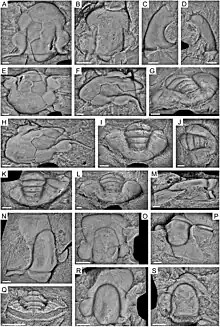| Veeversaspis Temporal range: Tremadocian, | |
|---|---|
 | |
| Specimens of Veeversaspis and Tanybregma | |
| Scientific classification | |
| Domain: | Eukaryota |
| Kingdom: | Animalia |
| Phylum: | Arthropoda |
| Class: | †Trilobita |
| Order: | †Proetida |
| Family: | †Bathyuridae |
| Genus: | †Veeversaspis Smith, and Allen, 2023 |
| Type species | |
| †Veeversaspis jelli Patrick M. Smith, and Heidi J. Allen, 2023 | |
Veeversaspis (IPA: [ˌvɪvəzˈæspɪs]) (meaning "Veevers' shield") is an extinct genus of bathyurid trilobite from the Nambeet Formation in Western Australia; Australia. The type species is M. jelli, known from multiple partial specimens.[1]
Description
Veeversaspis is known from multiple specimens which were described in 2023 by Smith, and Allen, (2023). The holotype, GSWAF55755 measures at around 14 mm (0.6 in), and is a partial cranidium.[1]
Etymology
The generic name, Veeversaspis (IPA: [ˌvɪvəzˈæspɪs]), is named in honour of J.J. Veevers (Macquarie University; Sydney), for the initial documentation of trilobites from the Canning Basin. And the Greek word "aspis" which means shield and is also a common component of trilobite generic names. The specific name, jelli (IPA: [dʒɛlaɪ]), was named in honour of P.A. Jell (University of Queensland; Brisbane), for his extensive contribution to Australian trilobite studies.[1]
References
- 1 2 3 Smith, Patrick; Allen, Heidi (7 August 2023). "Early Ordovician trilobites from Barnicarndy 1 stratigraphic well of the southern Canning Basin, Western Australia". Alcheringa: An Australasian Journal of Palaeontology. 47 (1): 234–291. Bibcode:2023Alch...47..234S. doi:10.1080/03115518.2023.2226194.
